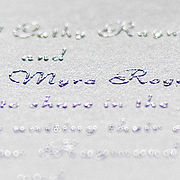
Thermographic printing
Encyclopedia

Thermographic printing refers to two types of printing
Printing
Printing is a process for reproducing text and image, typically with ink on paper using a printing press. It is often carried out as a large-scale industrial process, and is an essential part of publishing and transaction printing....
, both of which rely on heat to create the letters or images on a sheet of paper.
The simplest type is where the paper has been coated with a material that changes colour on heating. This is called thermal printing
Thermal printer
A thermal printer produces a printed image by selectively heating coated thermochromic paper, or thermal paper as it is commonly known, when the paper passes over the thermal print head. The coating turns black in the areas where it is heated, producing an image...
and was used in older model fax machines and is used in most shop till
Cash register
A cash register or till is a mechanical or electronic device for calculating and recording sales transactions, and an attached cash drawer for storing cash...
receipt
Receipt
A receipt is a written acknowledgment that a specified article or sum of money has been received as an exchange for goods or services. The receipt is evidence of purchase of the property or service obtained in the exchange.-Printed:...
printers. This is called direct thermal.
More complex is thermal ink transfer printing
Thermal transfer printer
A thermal transfer printer is a printer which prints on paper by melting a coating of ribbon so that it stays glued to the material on which the print is applied. It contrasts with direct thermal printing where no ribbon is present in the process...
that melts print off a ribbon and onto the sheet of paper.
Thermography as raised print process
Thermography is also the name of a post print process that is achieved today using traditional printing methods coupled with thermography machines. Thermography machines consist of three sections connected by a through conveyor.The first section applies powdered polymer to the entire sheet. The areas selected for raised printing are printed with inks that do not contain dryers or hardeners so that they remain wet during the application of powder. This ink is dried or hardened later during the heating process.
The second section of the process is a vacuum system that removes excess powder from uninked areas of the substrate.
The third section of the process conveys the product through a radiant oven where it is exposed to temperatures of 900 to 1300 degrees Fahrenheit. The heating process takes on the order of 2.5 to 3 seconds. The substrate (usually paper) has a peak in IR absorption at the wavelength used. Through conduction from the paper, the powder temperature rapidly increases and starts melting. When the process is correctly adjusted, the center of the largest filmed areas reach sufficient quality level as the product exits the heater. The melted ink then solidifies as the product cools.
This process is sometimes produced using manual powdering. The substrate with the wet ink areas selected for the effect are dipped into the powdered polymer. The sheet is tilted back and forth, rolling the powder across the image. The excess powder is removed by raising the substrate to a vertical position and lightly tapping the back. The powdered sheet is then fed into a radiant heating system as above at a speed to achieve a quality filming. In the case of craft applications, the powder is then melted using a heatgun that blows hot air.
It is commonly used on wedding invitations, letterheads, business cards, greetings cards, gift wrap, packaging and can also be used to print braille text. It is even sometimes used in diploma
Diploma
A diploma is a certificate or deed issued by an educational institution, such as a university, that testifies that the recipient has successfully completed a particular course of study or confers an academic degree. In countries such as the United Kingdom and Australia, the word diploma refers to...
printing as an attractive alternative to the more expensive engraving
Engraving
Engraving is the practice of incising a design on to a hard, usually flat surface, by cutting grooves into it. The result may be a decorated object in itself, as when silver, gold, steel, or glass are engraved, or may provide an intaglio printing plate, of copper or another metal, for printing...
option.

